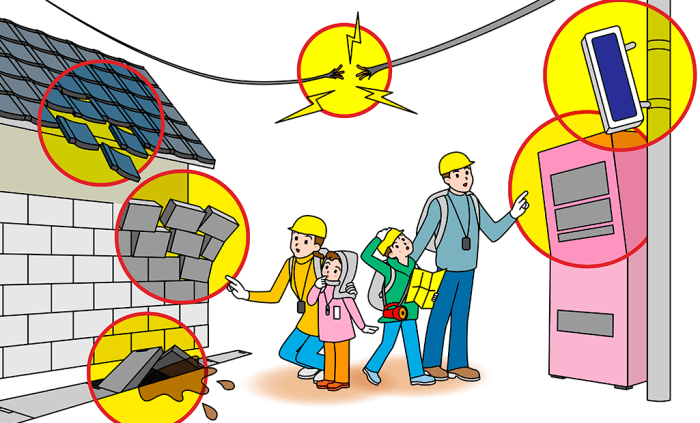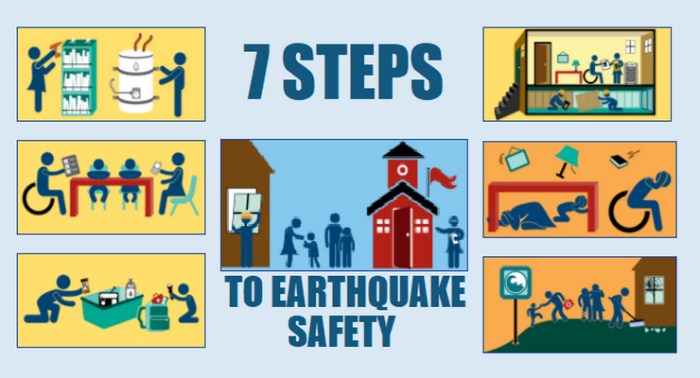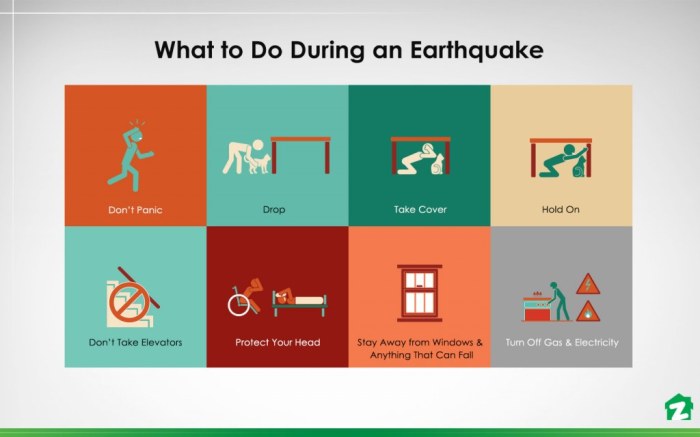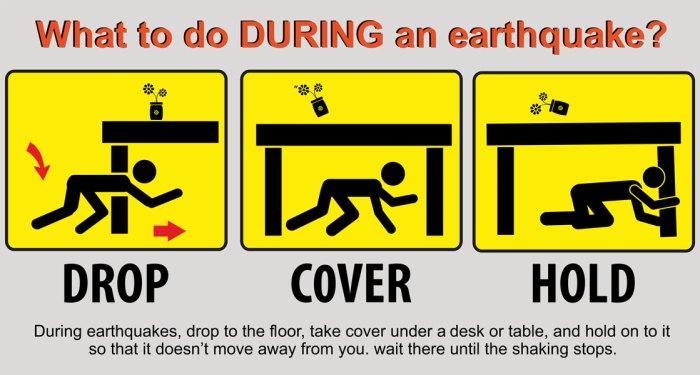How to Stay Safe in an Earthquake delves into the crucial steps you need to take to ensure your safety during this natural disaster. From preparing your emergency kit to knowing what to do during and after an earthquake, this guide will equip you with the necessary knowledge to protect yourself and your loved ones.
Understand Earthquake Basics

Understanding the basics of earthquakes is crucial for staying safe during these natural disasters. Let’s delve into what causes earthquakes, the different types of seismic waves, and how earthquakes are measured.
Causes of Earthquakes
Earthquakes are caused by the sudden release of energy in the Earth’s crust, resulting in seismic waves. This release of energy can be triggered by tectonic plate movements, volcanic activity, or human-induced activities like mining or reservoir-induced seismicity.
Types of Seismic Waves
Seismic waves are the vibrations that travel through the Earth during an earthquake. There are three main types of seismic waves: primary (P) waves, secondary (S) waves, and surface waves. P waves are the fastest and can travel through solids, liquids, and gases. S waves are slower and can only travel through solids. Surface waves are the slowest and cause the most damage to structures on the Earth’s surface.
Measurement of Earthquakes
Earthquakes are measured using the Richter scale and the Mercalli scale. The Richter scale measures the magnitude of an earthquake based on the amplitude of seismic waves. The Mercalli scale measures the intensity of an earthquake based on its effects on people, buildings, and the environment. Both scales provide valuable information to assess the impact of earthquakes on communities and infrastructure.
Preparing for an Earthquake

When it comes to preparing for an earthquake, there are several key steps you can take to ensure the safety of yourself and your loved ones. From assembling an emergency kit to creating a family emergency plan, being proactive is crucial in minimizing the risks associated with earthquakes.
Essential Items for an Emergency Kit
It is essential to have an emergency kit ready in case of an earthquake. Here are some items you should consider including:
- Water – at least one gallon per person per day for at least three days
- Non-perishable food items
- First aid kit
- Flashlight with extra batteries
- Personal hygiene items
- Whistle to signal for help
- Cash in small denominations
- Important documents (identification, insurance papers, etc.)
Creating a Family Emergency Plan, How to Stay Safe in an Earthquake
Having a family emergency plan in place can help ensure that everyone knows what to do in the event of an earthquake. Here are some key points to consider when creating your plan:
- Identify safe spots in each room of your home
- Determine a meeting place outside of your home in case of evacuation
- Assign responsibilities to each family member
- Practice regular drills to ensure everyone knows what to do
Securing Heavy Furniture and Appliances
Securing heavy furniture and appliances is important to prevent them from toppling over during an earthquake. Here are some tips on how to secure them:
- Anchor bookshelves, cabinets, and other tall furniture to the wall
- Use furniture straps to secure items like TVs and microwaves
- Install latches on cabinet doors to prevent them from opening and spilling contents
During an Earthquake: How To Stay Safe In An Earthquake

When an earthquake strikes, it is crucial to remain calm and take immediate action to protect yourself. Whether you are indoors, outdoors, or in a vehicle, there are specific steps you can follow to stay safe during the shaking.
Steps to Take when the Shaking Starts
- Drop down to your hands and knees to prevent being knocked over.
- Cover your head and neck with your arms to protect yourself from falling debris.
- Hold on to any sturdy furniture or object to maintain your position and prevent being tossed around.
- If you are near a table or desk, seek shelter underneath it to shield yourself from potential hazards.
- Avoid doorways, as they are no stronger than any other part of a building and do not provide additional protection.
What to Do if You are Indoors, Outdoors, or in a Vehicle
- If Indoors: Stay inside and take cover under a sturdy piece of furniture. Avoid windows, mirrors, and heavy objects that could shatter or fall.
- If Outdoors: Move to an open area away from buildings, trees, streetlights, and utility wires. Drop to the ground and cover your head and neck until the shaking stops.
- If in a Vehicle: Pull over to a safe location away from overpasses, bridges, and power lines. Stay inside the vehicle with your seat belt fastened until the shaking ceases.
How to Protect Yourself During the Earthquake
- Stay calm and try to remain in a safe position until the shaking stops.
- Avoid using elevators during an earthquake, as they may become stuck or malfunction.
- If you are in bed, cover your head with a pillow and stay put until the shaking subsides.
- Be prepared for aftershocks and be ready to take cover again if necessary.
- Listen for emergency alerts and follow instructions from local authorities to ensure your safety.
After an Earthquake

After an earthquake, it is crucial to prioritize safety and assess the situation around you to prevent further harm. Here are some important steps to take once the shaking stops.
Safety Tips for Checking for Injuries
- Check yourself and others for injuries immediately. Attend to any wounds or seek medical attention if needed.
- Avoid moving injured individuals unless they are in immediate danger. Wait for professional help to arrive.
- If you are trapped, try to signal for help by making noise or using a flashlight. Stay calm and conserve energy.
Importance of Checking Utilities
Assessing the status of utilities in your home is vital to avoid hazards and ensure your safety.
- Check for gas leaks by listening for hissing sounds or smelling gas. Turn off the gas supply if you suspect a leak and leave the area immediately.
- Inspect electrical lines for damage and refrain from using any appliances if there is visible damage or signs of sparking.
- Verify that water and sewage lines are intact to prevent contamination and health risks.
Assessing the Damage to Your Home
It is essential to evaluate the structural integrity of your home after an earthquake to determine if it is safe to stay inside.
- Look for cracks in walls, ceilings, or foundation that may indicate structural damage. Seek professional assessment if needed.
- Check for fallen objects or debris that could pose a threat. Clear pathways to ensure safe evacuation if necessary.
- Inspect windows, doors, and roof for damage to prevent further exposure to elements or intruders.
Concluding Remarks

In conclusion, staying safe during an earthquake requires preparation, quick thinking, and a clear plan of action. By following the guidelines provided in this article, you can increase your chances of surviving and minimizing the impact of this powerful force of nature. Stay safe and be prepared.